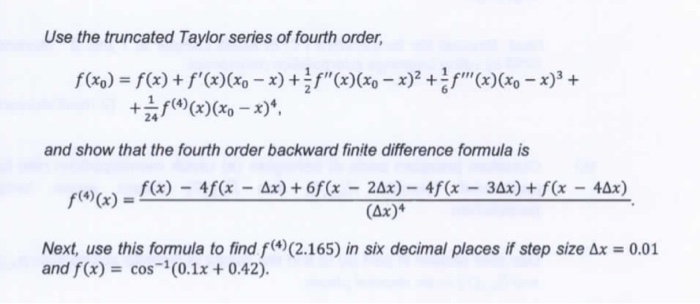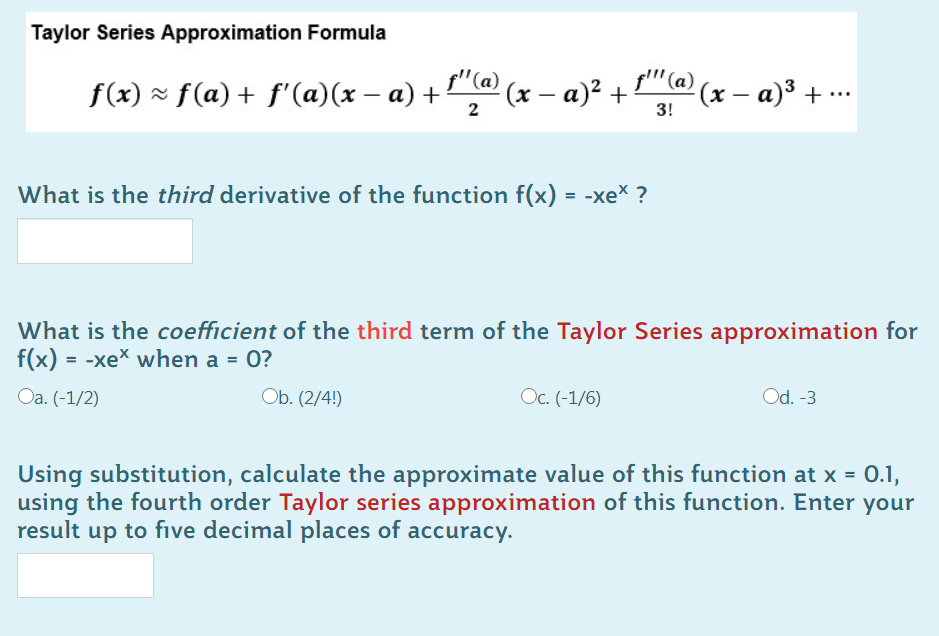The word order is used and equals the highest degree. Taylor series are named after brook taylor, who introduced them in 1715.

Solved Use The Truncated Taylor Series Of Fourth Order And | Chegg.com
(think about how k being even or odd affects the value of the k th derivative.)

Fourth order taylor. About press copyright contact us creators advertise developers terms privacy policy & safety how youtube works test new features press copyright contact us creators. F(1) = √5 take the first derivative f1(y) = [f0(y)] ′ [√x2 + 4] ′ = x √x2 + 4 So, find taylor series calculator evaluates the derivatives and calculate them at the given point, and substitute the obtained values into the series formula.
Computing the taylor expansion for sin and cos separately then multiplying the result together, or computing the taylor expansion for the. Gist 1 — python code for finding nth order taylor polynomial terms on each iteration:. Find the taylor polynomial of order 4 4 generated by f(x) = sin2x f ( x) = sin 2 x in the point a = π 4 a = π 4.
Then find the fourth order taylor polynomial p4(x) for sin(x) centered at 0. So you can say sin ( x) = x + r 1 ( x) is the first order expansion, sin ( x) = x − x 3 3! Add the derivative to the derivatives list while simultaneously substituting t with a;
Compute the fourth order taylor expansion for sin (x) and cos (x) and sin (x)cos (x) around 0.write down your manual calculation and python script to answer above’s questionwhich produces less error for x=p/2: You may assume that x is an array, and n is a positive integer (including zero). Compute the fourth order taylor expansion for sin(x) and cos(x) and sin(x)cos(x) around 0.
F0(y) = f(y) = √x2 + 4 evaluate function: The fourth order taylor expansions for sin (x) and cos (x) around 0 are: Now a taylor expansion is written up to a remainder term, with as many terms as you like.
Recursively call taylor_termspassing in the most recently evaluated ith derivative of func (in terms of t) specified.; Taylor polynomial the taylor polynomial of a function at a a is the polynomial that. 24/7 help from expert tutors on 140+ subjects;
Use the fourth order taylor series to approximate and determine the truncation error bound. About press copyright contact us creators advertise developers terms privacy policy & safety how youtube works test new features press copyright contact us creators. 0.01 use the truncated taylor series of fourth.
Write down your manual calculation and python script to answer above’s question; Compute the fourth order taylor expansion for sin and cos , and sin cos around 0, which produces. + r 3 ( x) is the third order expansion, sin ( x) = x − x 3 3!
Syms x f = sin(x)/x; For most common functions, the function and the sum of its taylor series are equal near this point. Calculate the first four derivatives of f(x) at x = 0.
In mathematics, the taylor series of a function is an infinite sum of terms that are expressed in terms of the function's derivatives at a single point. Write a function my_cosh_approximator (x, n) where output is the n th order taylor series approximation for , the hyperbolic cosine of x taken around. Use order to control the truncation order.
Compute the fourth order taylor expansion for sin(x) and cos(x) and. Find the ith symbolic derivative of func w.r.t t; Based on your results from part (i), find a general formula for f ( k) (0).
+ r 5 ( x) is the fifth order expansion. Full access to over 1 million textbook solutions;
Zero Order Approximation With 4Th Order Taylor Series Expansion Of... | Download Scientific Diagram
